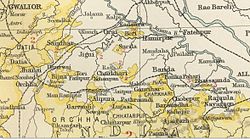Jigni State
| Jigni State जिगनी रियासत | |||||||
|---|---|---|---|---|---|---|---|
| Princely State of British India | |||||||
| 1730–1950 | |||||||
 Jigni State in the Imperial Gazetteer of India | |||||||
| Area | |||||||
• 1901 | 57 km2 (22 sq mi) | ||||||
| Population | |||||||
• 1901 | 3838 | ||||||
| History | |||||||
| History | |||||||
• Established | 1730 | ||||||
| 1950 | |||||||
| |||||||
| Today part of | Hamirpur district, Uttar Pradesh, India | ||||||
Jigni State was a princely state of the Bundelkhand Agency of the British Raj. It was a small Sanad state of about 82.87 km2 with a population of 4,297 inhabitants in 1901. The state was surrounded by the Hamirpur[1] and Jhansi districts of the United Provinces.
Its capital was at Jigni, also known as Jigini.[2] It is a small town —1,770 inhabitants in 1901— located near the confluence of the Dhasan and the Betwa River[3] in present-day Rath tehsil of Hamirpur district, Uttar Pradesh.
History[edit]
Jigni State was founded as a jagir in 1730 by Rao Padam Singh, a Rajput of the Bundela clan. He was a son of Chhatrasal, the founder of Panna State. Originally the jagir had been larger, but its size was much reduced during the Maratha invasion in the last half of the eighteenth century.[3]
Jigni became a British protectorate in 1810 under the rule of Pirthi Singh.[4] Rao Bhupendra Vijai Singh, the last ruler of Jigni State signed the instrument of accession to India in 1947, the state becoming part of the Indian Union on 1 January 1950.[5]
Rulers[edit]
The ruling family were members of the Bundela clan of Rajputs.[5] The rulers used the title of Rao.[4]
Title Rao[edit]
| 1730–1790 | Padam Singh | (d. 1790) |
| 1790–1806 | Lakshman Singh I | |
| 1806–1830 | Pirthi Singh | (d. 1830) |
| 1830–1870 | Bhopal Singh | (b. 1830 – d. 1870) |
| 1870–1892 | Lakshman Singh II | (b. 1860 – d. 1892) |
| 1892–1925 | Bhanu Pratap Singh | (b. 1878 – d. 1925) |
| 1925–1934 | Arimardan Singh | (b. 1903 – d. 1941) |
| 1934 – 15 August 1947 | Bhupendra Vijai Singh |
See also[edit]
References[edit]
- ↑ Chisholm, Hugh, ed. (1911). . Encyclopædia Britannica. Vol. 12 (11th ed.). Cambridge University Press. p. 893.
- ↑ Jigini Village in Rath (Hamirpur) Uttar Pradesh
- ↑ 3.0 3.1 Imperial Gazetteer of India, v. 14, p. 165.
- ↑ 4.0 4.1 Princely States of India A-J
- ↑ 5.0 5.1 "Jigni Princely State". Archived from the original on 10 July 2015. Retrieved 21 August 2015.